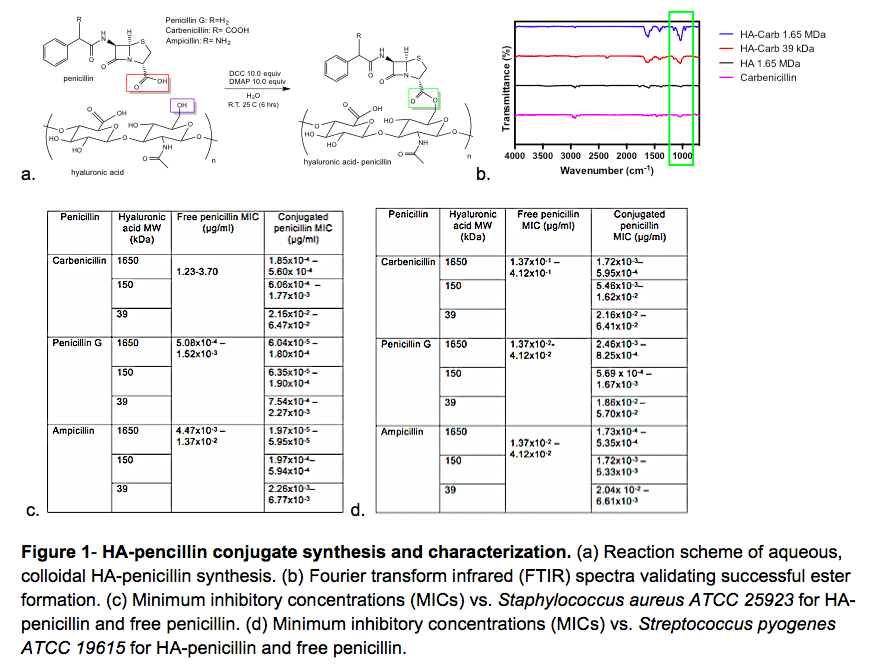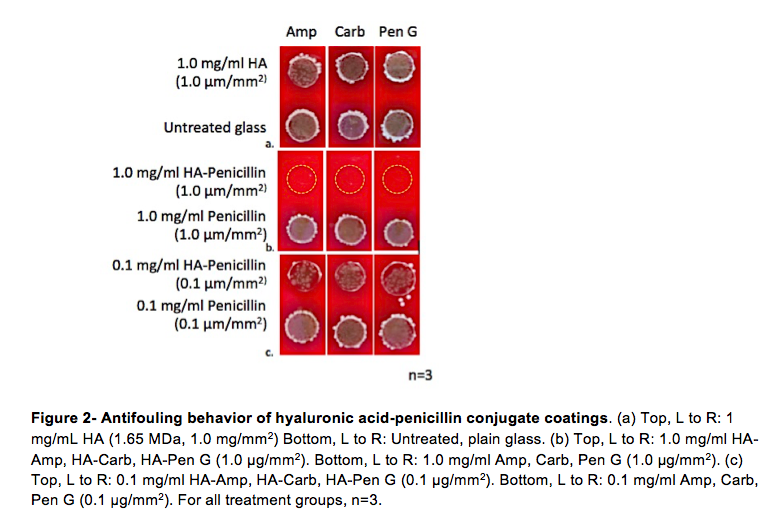Introduction: Bacterial infections remain among the leading causes of death worldwide and are becoming increasingly difficult to treat due to rising rates of antibacterial resistance. There is a critical need for new, effective antibiotics that eradicate bacteria before resistance can develop. Antimicrobial polymers can be used to prevent and treat infection in a variety of applications, including antifouling coatings. Synthesis of most common antimicrobial polymers, such as quaternary ammonium polymers, involves harsh solvents to yield an often cytotoxic and marginally effective product[1]. Here, we describe the aqueous synthesis of a polymer-drug conjugate utilizing FDA-approved and naturally occurring hyaluronic acid (HA) and existing penicillin antibiotics. Our novel conjugates display superior antibacterial efficacy compared to non-conjugated penicillins, while also preventing the attachment of bacteria.
Methods: Synthesis: Colloidal carbodiimide chemistry[2] was used to conjugate one of three penicillins (carbenicillin, penicillin G, and ampicillin) to HA (at three average molecular weights: 39, 150, and 1650 kDa) via an ester bond [Fig 1a]. Characterization: The structure, size, and percent conjugation of the products was determined using Fourier transform-infrared spectroscopy (FTIR) and size exclusion chromatography (SEC). Antibacterial efficacy was determined using a broth microdilution assay versus Staphylococcus aureus and Streptococcus pyogenes as previously reported[3]. Bovine erythrocyte hemolysis was examined by measuring hemoglobin absorbance at 540 nm. Bacterial attachment characterization: The 1650 kDa conjugates were coated on 12 mm round cover glass at two surface concentrations (1.0 and 0.1 mg/mm2) and incubated with S. aureus for 1 hour, rinsed in PBS, and immediately plated onto blood agar along with controls.
Results and Discussion: FTIR validated successful ester formation (strong ester C-O stretch at ~1050 cm-1) [Fig. 1b] and SEC confirmed efficient conjugation (≥ 90%) [Fig 1c]. The broth microdilution assays demonstrated that all of the conjugates are at least 10x more effective than the penicillin alone against S. aureus and S. pyogenes (based on the number of penicillin molecules present), with higher HA molecular weight leading to increased efficacy [Fig 1d,e]. Bacteria were unable to attach to the conjugate coated glass at a surface concentration of 1.0 mg/mm2 [Fig. 2]. Bacterial attachment is the first step of biofilm formation[4], motivating the coating as an antifoulant. Moreover, all conjugates were determined to be biocompatible, causing hemolysis at concentrations 102-104x their minimum inhibitory concentrations (MICs).


Conclusion: A library of HA-penicillin conjugates was developed that exhibits antifouling behavior. Each conjugate was significantly more effective in eradicating bacteria than penicillin alone. By reducing the amount of penicillin necessary to effectively eradicate bacteria, drug exposure is reduced, helping to prevent the development of resistance.
United States Office of Naval Research (ONR); School of Engineering, Brown University, Providence, RI USA
References:
[1] Álvarez-Paino, M.et al. Biomacromolecules. 2015, 16, 295-303.
[2] Manju, S.; Sreenivasan, K. J. Colloid Interface Sci. 2011, 359, 318.
[3] Engler, A; Shukla, A. et al. Biomacromolecules. 2011, 12 (5) 1666-1674.
[4] Palmer, J.; Flint, S.; Brooks, J. Ind. Microbiol. Biotechnol. 2007, 34 (9), 577–588.